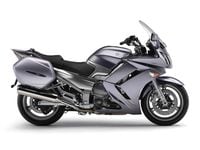Among motorcyclists, many of whom believe cars are boring and soulless, the term “automotive” as applied to a bike is a slam of epic proportions. Depending on the job at hand, however, a bit of car-ness is a good thing. If, for example, it’s pouring rain and you’re three states from home, there’s a good chance you’ll forgive your bike its lack of charisma as long as it gets you home without drama. In a situation like that you could do a lot worse than to be sitting on a Honda ST1100.
The ST1100's 1,085cc longitudinal V-4 churned out 100 hp and 79 pound-feet of torque and was tougher to kill than a cockroach—with minimal maintenance most would easily reach 100,000 miles without a whimper. A bank of four carbs nestled between the vee of the cylinders, accessible by removing the dummy tank cover; the real gas tank was under the seat and held 7.4 gallons, enough to put almost 300 miles behind you at a stretch. The shaft drive produced a bit of hop under hard acceleration, but the bike's heft—635 pounds dry, according to Honda—damped some of it.
The chassis was built for comfort, not for speed, though the ST would hustle down a back road if prodded. Twin front discs worked with a single rear to slow the beast, and optional ABS and traction control added to the feeling of security; 1996-and-later ABS models came with linked brakes. A pair of detachable saddlebags and a big fairing fulfilled the “touring” part of the sport-touring formula.
The stock windscreen made few friends; most riders shelved it for an aftermarket screen. Some riders liked the stock seats, while others phoned their favorite custom-seat makers immediately. The low handlebar was often replaced by one a bit higher and wider. In 1996, Honda replaced the problematic 28-amp alternator with an improved 40-amp unit, making the later models the way to go if you add a lot of power-sucking electrical gadgets. The early models can be upgraded, but it’s not a simple bolt-on operation.
Valve-adjust intervals are long (16,000 miles), but the timing belt should be replaced every 80,000 miles; fudge that figure and you risk an engine full of bent valves. The coolant hoses on some high-mileage bikes get brittle and crack, and they’re under the carb bank so they’re a major pain to replace; the speedo cable and headlight bulbs aren’t much fun either. In the rain the bike throws a lot of splash up under the rear end, which is hidden by the bags; check the rear brake caliper, the mufflers, and the underside of the swingarm for rust and corrosion.
The ST1100 might be dated by today's standards, but it benefits from an extremely loyal and knowledgeable fan base, legendary reliability and longevity, and a typically bargain-basement price on the used market. Don't be afraid to look at high-mileage examples as long as they don't show any obvious signs of distress. Change the screen and get a better seat, and spend the money you save over a newer sport-tourer on several years of vacations.
Tough, solid, reliable, will get you there and back. Automotive, in a good way.
Weight, glitchy early alternators, odd-size tires. No amount of tinkering will turn it into a BMW.
Undercarriage rust, sticky rear brake caliper, timing belt past its change-by date.
For sport-tourers who prefer function over flash, the ST1100 still delivers.
1991 / $2,485 1993 / $2,605 1995 / $2,975 1997 / $3,250 1999 / $3,620 2001 / $4,160 2002 / $4,555
Perhaps the anti-ST1100, the sport-touring ST2 borrowed the Paso’s liquid-cooled, two-valve engine, bumped it up to 944cc, and wrapped it in much less controversial bodywork. Charming, quick, and good handling; it needed to be, given Ducati’s reputation for reliability at the time.
No one expected the original Ninja 900R to survive more than two decades, and it didn’t. But the bike’s basic engine carried over to the Concours 1000, which for 21 model years was Kawasaki’s sole sport-touring machine. Fast and sophisticated when new, it began to show its age by the end of the 1990s, replaced by the genuinely fast Concours 14.
Hard to imagine now, but Yamaha’s US arm wasn’t sure it could sell the FJR1300 here. Euro-styled sport-tourers had failed to sell in big numbers. So Yamaha made the first bike available on special order to hedge bets and see how demand went. It was strong from the start, guaranteeing a long life for the FJR. The core of the 2015 model is, amazingly, closely related to the original.















/cloudfront-us-east-1.images.arcpublishing.com/octane/FZXHNOQRNVA3BIDWAF46TSX6I4.jpg)
/cloudfront-us-east-1.images.arcpublishing.com/octane/JRSFLB2645FVNOQAZCKC5LNJY4.jpg)
/cloudfront-us-east-1.images.arcpublishing.com/octane/ITNLTIU5QZARHO733XP4EBTNVE.jpg)
/cloudfront-us-east-1.images.arcpublishing.com/octane/VZZXJQ6U3FESFPZCBVXKFSUG4A.jpg)
/cloudfront-us-east-1.images.arcpublishing.com/octane/QCZEPHQAMRHZPLHTDJBIJVWL3M.jpg)
/cloudfront-us-east-1.images.arcpublishing.com/octane/HXOUJXQWA5HBHGRO3EMJIGFMVI.jpg)

/cloudfront-us-east-1.images.arcpublishing.com/octane/3TIWWRV4JBBOLDVGRYECVVTA7Y.jpg)
/cloudfront-us-east-1.images.arcpublishing.com/octane/KIX5O23D5NAIBGFXBN3327DKZU.jpg)
/cloudfront-us-east-1.images.arcpublishing.com/octane/7GJYDUIPXRGMTMQKN6ONYOLBOU.jpg)
/cloudfront-us-east-1.images.arcpublishing.com/octane/MUQLOVLL2ZDGFH25ILABNBXKTI.jpg)
/cloudfront-us-east-1.images.arcpublishing.com/octane/TNOU5DNE2BC57MFPMGN2EIDXAM.jpg)
/cloudfront-us-east-1.images.arcpublishing.com/octane/GTCXACQGJ5HAPDTGWUQKDEH44E.jpg)
/cloudfront-us-east-1.images.arcpublishing.com/octane/S35YGSEMEZB4BLTDJTSZPF4GLA.jpg)
/cloudfront-us-east-1.images.arcpublishing.com/octane/5UOT6HPX2JFMRJAX6EH45AR4MQ.jpg)
/cloudfront-us-east-1.images.arcpublishing.com/octane/OKWOJWAKP5EP3OACCRRWPCIX2Q.jpg)
/cloudfront-us-east-1.images.arcpublishing.com/octane/2WF3SCE3NFBQXLDNJM7KMXA45E.jpg)
/cloudfront-us-east-1.images.arcpublishing.com/octane/G4MG6OUCJNBSHIS2MVVOTPX65E.jpg)
/cloudfront-us-east-1.images.arcpublishing.com/octane/IIGGWFOTOJGB7DB6DGBXCCMTDY.jpg)
/cloudfront-us-east-1.images.arcpublishing.com/octane/QSTCM6AVEZA5JJBUXNIQ3DSOF4.jpg)
/cloudfront-us-east-1.images.arcpublishing.com/octane/U4I7G625B5DMLF2DVIJDFZVV6M.jpg)
/cloudfront-us-east-1.images.arcpublishing.com/octane/B6XD6LS6IVCQPIU6HXDJSM3FHY.jpg)
/cloudfront-us-east-1.images.arcpublishing.com/octane/ICL63FEDDRDTTMINYICCEYGMDA.jpg)
/cloudfront-us-east-1.images.arcpublishing.com/octane/FCGZHQXRBZFLBAPC5SDIQLVF4I.jpg)